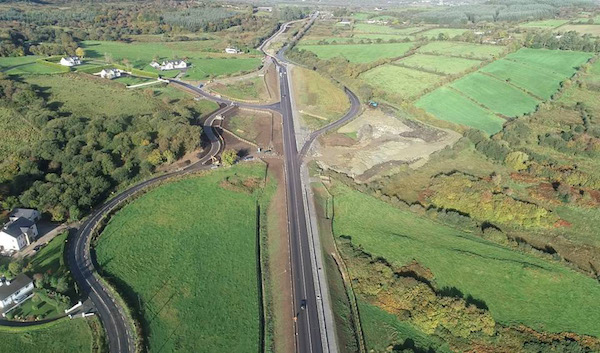Road users across Donegal are seeing the culmination of years of work in roadworks underway, says Donegal County Council.
Here, Aine McHugh, executive engineer with Donegal County Council’s National Roads Office, said those works also illustrate the NRO’s priorities.
“It’s really about the connections between places where people work, live, and socialise, and making Donegal that wee bit closer to the rest of the country,” she said.
“Our office is about getting people to places in as safe and as reliable a way as we can, and opening up the north-west for investment, employment, tourism, and all the other things the north-west can offer.”
“While construction is the most public phase of a project, it only begins after the NRO has completed an often long and complicated process that includes initial feasibility, route selection, planning, CPO/land acquisition, detailed design and tendering – work that can take years in some cases.
“Information is gathered during development of a scheme from consultation and input from the public, environmental and traffic studies, existing ground profiles, and ground and archaeological investigations. All projects are subject to national rating and appraisal, so justifying getting each scheme funded is a major task.
“And then the roads built and the traffic is on it, and it’s like it was always there,” Aine said.
“That’s the best part, when you get your scheme built and you can see the planning turned into reality, and you can see the benefits that people get from it.”
Crews are on site at several major works in the county: realignment of the stretch of the N56 known locally as the Blue Banks, from Coolboy to Kilmacrennan; of the N56 from Mountcharles to Drumbeigh; of the N56 from north of Glenties to Boyoughter, part of the upgrade from Dungloe to Kilraine; and the next phase of Blackburn Bridge works on the N15, from Cappry to Ballybofey.
“You’re building quite a large, high-standard road while still maintaining traffic of 7,000 vehicles a day, which is one of the most difficult parts of that type of road construction,” Aine said. “One of the challenges is making sure everybody can get to work, get to school, get to wherever they have to be, and still build the road safely and efficiently.”
Regional Donegal NRO teams serve the north-west with an overall €34 million budget for 2018.
As well as roadworks, the NRO is also responsible for 39,000 signs, more than 4,500km of road lining, at least 730 structures, and an extensive road safety programme covering seven counties, including Donegal, Leitrim, Sligo, Galway, Monaghan, and Cavan.
The €12 million pavement programme is providing renewal and repair over a length of 32km on the national network throughout Donegal, and the bridge management section have advanced schemes throughout the region, including the new footbridge at the River Finn in Ballybofey.
The NRO work closely with Transport Infrastructure Ireland, formerly the National Roads Authority.
“We work to very high-quality standards laid out by the TII, and you need to meet these standards while identifying local needs, and integrate it as best you can with the existing environment to minimize the impact on people and property,” Aine said. “It’s not an easy task.”
The benefits are tangible. She pointed to the work on the N56 near Glenties that has already eliminated the “Gweebarra bends” and “Meenacarn bends” as an example.
“That’s a good example in that it is a part of the county where the scenery is spectacular and it’s such a high tourism attraction, but buses were finding it difficult to manoeuvre along that road because of the tight bends,” Aine said. “These improvements have made this area more accessible for bus tours and opened up that part of the county even more for tourism.”
Cycleways and footways are a new addition to national roads projects. The N56 from Dungloe to Glenties and the new road at the Blue Banks will include cycleways, adding to road safety.
Aine has been with the NRO since 2004 and was introduced to the council roads section earlier, when she was studying civil engineering at Queens University Belfast – one of five women in a class of 75 – and worked for the council for several summers during her studies.
NRO engineers always have several major projects at different stages on the go as well as ongoing maintenance and improvements. During the economic downturn, the council adopted a strategy of working on smaller roads projects and doing the planning and design necessary to get work “shovel-ready”.
“Then when money became available, we were one of the first off the block,” Aine said.
The NRO are also progressing other major works through the design phase. “We are now working towards some really important larger projects and it’s great to see the progression of the Trans European Transport Network project, which includes the N14 Manorcunningham to Lifford, the N15/N13 Ballybofey-Stranorlar area, and the N56/N13/N14 Letterkenny to Manorcunningham.
“These road improvement schemes are so badly needed in the county,” she said.
Tags:









